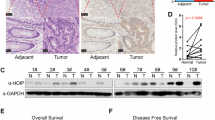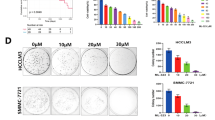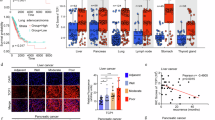Abstract
The cellular prion protein (PrPC) is associated with metastasis, tumor progression and recurrence; however, the precise mechanisms underlying its action is not well understood. Our study found that PrPC degradation decreased tumor progression in colorectal cancer (CRC). In a CRC cell line and human CRC tissue exposed to hypoxia, induced heat-shock 70-kDa protein-1-like (HSPA1L) expression stabilized hypoxia-inducible factor-1α (HIF-1α) protein and promoted PrPC accumulation and tumorigenicity in vivo. PrPC was degraded via the proteasome pathway mediated by the ubiquitin-protein E3 ligase glycoprotein 78 (GP78), which interacts directly with PrPC. However, hypoxia-induced HSPA1L interacted with GP78 and inhibited its functions. HSPA1L knockdown facilitated the interaction of GP78 and PrPC, thereby increasing PrPC ubiquitination. Thus, GP78 was identified as the ubiquitinase for PrPC, thereby revealing an essential mechanism that controls PrPC levels in CRC. Our results suggest that the HSPA1L/HIF-1α/GP78 axis has a crucial role in PrPC accumulation during tumor progression.
This is a preview of subscription content, access via your institution
Access options
Subscribe to this journal
Receive 50 print issues and online access
$259.00 per year
only $5.18 per issue
Buy this article
- Purchase on SpringerLink
- Instant access to full article PDF
Prices may be subject to local taxes which are calculated during checkout







Similar content being viewed by others
References
Jemal A, Siegel R, Ward E, Hao Y, Xu J, Murray T et al. Cancer statistics, 2008. CA Cancer J Clin 2008; 58: 71–96.
Srivastava S, Ludwig AK, Wong JW, Hesson LB . An investigation of the potential for epigenetic inactivation by transcription read-through in a sporadic colorectal cancer. Gene 2016; 585: 154–158.
Ward HA, Norat T, Overvad K, Dahm CC, Bueno-de-Mesquita HB, Jenab M et al. Pre-diagnostic meat and fibre intakes in relation to colorectal cancer survival in the European Prospective Investigation into Cancer and Nutrition. Br J Nutr 2016; 116: 316–325.
Young GP, Hu Y, Le Leu RK, Nyskohus L . Dietary fibre and colorectal cancer: a model for environment–gene interactions. Mol Nutr Food Res 2005; 49: 571–584.
Boyle P, Ferlay J . Cancer incidence and mortality in Europe, 2004. Ann Oncol 2005; 16: 481–488.
Bartolini A, Cardaci S, Lamba S, Oddo D, Marchio C, Cassoni P et al. BCAM and LAMA5 mediate the recognition between tumor cells and the endothelium in the metastatic spreading of KRAS-mutant colorectal cancer. Clin Cancer Res 2016; 22: 4923–4933.
Welch HG, Robertson DJ . Colorectal cancer on the decline—why screening can't explain it all. N Engl J Med 2016; 374: 1605–1607.
Chiche L, Rinchai D, Chaussabel D . CDX2 as a prognostic biomarker in colon cancer. N Engl J Med 2016; 374: 2183–2184.
Prusiner SB . Shattuck lecture—neurodegenerative diseases and prions. N Engl J Med 2001; 344: 1516–1526.
Weissmann C . The state of the prion. Nat Rev Microbiol 2004; 2: 861–871.
Zomosa-Signoret V, Arnaud JD, Fontes P, Alvarez-Martinez MT, Liautard JP . Physiological role of the cellular prion protein. Vet Res 2008; 39: 9.
Cheng Y, Tao L, Xu J, Li Q, Yu J, Jin Y et al. CD44/cellular prion protein interact in multidrug resistant breast cancer cells and correlate with responses to neoadjuvant chemotherapy in breast cancer patients. Mol Carcinogen 2014; 53: 686–697.
de Wit M, Jimenez CR, Carvalho B, Belien JA, Delis-van Diemen PM, Mongera S et al. Cell surface proteomics identifies glucose transporter type 1 and prion protein as candidate biomarkers for colorectal adenoma-to-carcinoma progression. Gut 2012; 61: 855–864.
Vilches S, Vergara C, Nicolas O, Mata A, Del Rio JA, Gavin R . Domain-specific activation of death-associated intracellular signalling cascades by the cellular prion protein in neuroblastoma cells. Mol Neurobiol 2016; 53: 4438–4448.
Wang Q, Qian J, Wang F, Ma Z . Cellular prion protein accelerates colorectal cancer metastasis via the Fyn-SP1-SATB1 axis. Oncol Rep 2012; 28: 2029–2034.
Li QQ, Sun YP, Ruan CP, Xu XY, Ge JH, He J et al. Cellular prion protein promotes glucose uptake through the Fyn-HIF-2alpha-Glut1 pathway to support colorectal cancer cell survival. Cancer Sci 2011; 102: 400–406.
Du L, Rao G, Wang H, Li B, Tian W, Cui J et al. CD44-positive cancer stem cells expressing cellular prion protein contribute to metastatic capacity in colorectal cancer. Cancer Res 2013; 73: 2682–2694.
Grillari J, Grillari-Voglauer R, Jansen-Durr P . Post-translational modification of cellular proteins by ubiquitin and ubiquitin-like molecules: role in cellular senescence and aging. Adv Exp Med Biol 2010; 694: 172–196.
Lecker SH, Goldberg AL, Mitch WE . Protein degradation by the ubiquitin-proteasome pathway in normal and disease states. J Am Soc Nephrol 2006; 17: 1807–1819.
Jain AK, Barton MC . Making sense of ubiquitin ligases that regulate p53. Cancer Biol Ther 2010; 10: 665–672.
Li N, Zhang Y, Han X, Liang K, Wang J, Feng L et al. Poly-ADP ribosylation of PTEN by tankyrases promotes PTEN degradation and tumor growth. Genes Dev 2015; 29: 157–170.
Li N, Lorenzi F, Kalakouti E, Normatova M, Babaei-Jadidi R, Tomlinson I et al. FBXW7-mutated colorectal cancer cells exhibit aberrant expression of phosphorylated-p53 at Serine-15. Oncotarget 2015; 6: 9240–9256.
Jones MF, Hara T, Francis P, Li XL, Bilke S, Zhu Y et al. The CDX1-microRNA-215 axis regulates colorectal cancer stem cell differentiation. Proc Natl Acad Sci USA 2015; 112: E1550–E1558.
Chang YW, Tseng CF, Wang MY, Chang WC, Lee CC, Chen LT et al. Deacetylation of HSPA5 by HDAC6 leads to GP78-mediated HSPA5 ubiquitination at K447 and suppresses metastasis of breast cancer. Oncogene 2016; 35: 1517–1528.
Zhang T, Kho DH, Wang Y, Harazono Y, Nakajima K, Xie Y et al. Gp78, an E3 ubiquitin ligase acts as a gatekeeper suppressing nonalcoholic steatohepatitis (NASH) and liver cancer. PLoS One 2015; 10: e0118448.
Peer CJ, Sissung TM, Figg WD . CHIP and gp78-mediated ubiquitination of CYP3A4: Implications for the pharmacology of anticancer agents. Cancer Biol Ther 2011; 11: 549–551.
Lianos GD, Alexiou GA, Mangano A, Mangano A, Rausei S, Boni L et al. The role of heat shock proteins in cancer. Cancer Lett 2015; 360: 114–118.
Ledford H . Cancer theory faces doubts. Nature 2011; 472: 273.
Azad AA, Zoubeidi A, Gleave ME, Chi KN . Targeting heat shock proteins in metastatic castration-resistant prostate cancer. Nat Rev Urol 2015; 12: 26–36.
Sherman MY, Gabai VL . Hsp70 in cancer: back to the future. Oncogene 2015; 34: 4153–4161.
Mirzaei MR, Kazemi Arababadi M, Asadi MH, Mowla SJ . Altered expression of high molecular weight heat shock proteins after OCT4B1 suppression in human tumor cell lines. Cell J 2016; 17: 608–616.
Atarod S, Turner B, Pearce KF, Ahmed SS, Norden J, Bogunia-Kubik K et al. Elevated level of HSPA1L mRNA correlates with graft-versus-host disease. Transplant Immunol 2015; 32: 188–194.
Wellner U, Schubert J, Burk UC, Schmalhofer O, Zhu F, Sonntag A et al. The EMT-activator ZEB1 promotes tumorigenicity by repressing stemness-inhibiting microRNAs. Nat Cell Biol 2009; 11: 1487–1495.
Park JY, Jeong JK, Lee JH, Moon JH, Kim SW, Lee YJ et al. Induction of cellular prion protein (PrPc) under hypoxia inhibits apoptosis caused by TRAIL treatment. Oncotarget 2015; 6: 5342–5353.
Natalwala A, Spychal R, Tselepis C . Epithelial–mesenchymal transition mediated tumourigenesis in the gastrointestinal tract. World J Gastroenterol 2008; 14: 3792–3797.
Brabletz T, Jung A, Spaderna S, Hlubek F, Kirchner T . Opinion: migrating cancer stem cells—an integrated concept of malignant tumour progression. Nat Rev Cancer 2005; 5: 744–749.
Rieger R, Edenhofer F, Lasmezas CI, Weiss S . The human 37-kDa laminin receptor precursor interacts with the prion protein in eukaryotic cells. Nat Med 1997; 3: 1383–1388.
Luo W, Zhong J, Chang R, Hu H, Pandey A, Semenza GL . Hsp70 and CHIP selectively mediate ubiquitination and degradation of hypoxia-inducible factor (HIF)-1alpha but Not HIF-2alpha. J Biol Chem 2010; 285: 3651–3663.
Pratt WB, Morishima Y, Peng HM, Osawa Y . Proposal for a role of the Hsp90/Hsp70-based chaperone machinery in making triage decisions when proteins undergo oxidative and toxic damage. Exp Biol Med (Maywood) 2010; 235: 278–289.
Chieng CK, Say YH . Cellular prion protein contributes to LS 174T colon cancer cell carcinogenesis by increasing invasiveness and resistance against doxorubicin-induced apoptosis. Tumour Biol 2015; 36: 8107–8120.
Corsaro A, Bajetto A, Thellung S, Begani G, Villa V, Nizzari M et al. Cellular prion protein controls stem cell-like properties of human glioblastoma tumor-initiating cells. Oncotarget 2016; 7: 38638–38657.
Lee SH, Suh HN, Lee YJ, Seo BN, Ha JW, Han HJ . Midkine prevented hypoxic injury of mouse embryonic stem cells through activation of Akt and HIF-1alpha via low-density lipoprotein receptor-related protein-1. J Cell Physiol 2012; 227: 1731–1739.
Powles T, Lackner MR, Oudard S, Escudier B, Ralph C, Brown JE et al. Randomized Open-Label Phase II Trial of Apitolisib (GDC-0980), a novel inhibitor of the PI3K/mammalian target of rapamycin pathway, versus everolimus in patients with metastatic renal cell carcinoma. J Clin Oncol 2016; 34: 1660–1668.
Chang E, Liu H, Unterschemmann K, Ellinghaus P, Liu S, Gekeler V et al. 18F-FAZA PET imaging response tracks the reoxygenation of tumors in mice upon treatment with the mitochondrial complex I inhibitor BAY 87-2243. Clin Cancer Res 2015; 21: 335–346.
El-Naggar AM, Veinotte CJ, Cheng H, Grunewald TG, Negri GL, Somasekharan SP et al. Translational activation of HIF1alpha by YB-1 promotes sarcoma metastasis. Cancer Cell 2015; 27: 682–697.
Amelio I, Inoue S, Markert EK, Levine AJ, Knight RA, Mak TW et al. TAp73 opposes tumor angiogenesis by promoting hypoxia-inducible factor 1alpha degradation. Proc Natl Acad Sci USA 2015; 112: 226–231.
Zhang D, Li J, Costa M, Gao J, Huang C . JNK1 mediates degradation HIF-1alpha by a VHL-independent mechanism that involves the chaperones Hsp90/Hsp70. Cancer Res 2010; 70: 813–823.
Liu X, Chen S, Tu J, Cai W, Xu Q . HSP90 inhibits apoptosis and promotes growth by regulating HIF-1alpha abundance in hepatocellular carcinoma. Int J Mol Med 2016; 37: 825–835.
Wigerup C, Pahlman S, Bexell D . Therapeutic targeting of hypoxia and hypoxia-inducible factors in cancer. Pharmacol Ther 2016; 164: 152–169.
Minet E, Mottet D, Michel G, Roland I, Raes M, Remacle J et al. Hypoxia-induced activation of HIF-1: role of HIF-1alpha-Hsp90 interaction. FEBS Lett 1999; 460: 251–256.
Mo JH, Choi IJ, Jeong WJ, Jeon EH, Ahn SH . HIF-1alpha and HSP90: target molecules selected from a tumorigenic papillary thyroid carcinoma cell line. Cancer Sci 2012; 103: 464–471.
Nagaraju GP, Long TE, Park W, Landry JC, Taliaferro-Smith L, Farris AB et al. Heat shock protein 90 promotes epithelial to mesenchymal transition, invasion, and migration in colorectal cancer. Mol Carcinogen 2015; 54: 1147–1158.
Hu Y, Bai J, Hou SX, Tang JS, Shi XX, Qin J et al. Hypoxia-inducible factor 1-alpha regulates cancer-inhibitory effect of human mesenchymal stem cells. Cell Biochem Biophys 2015; 72: 131–136.
Gabai VL, Meng L, Kim G, Mills TA, Benjamin IJ, Sherman MY . Heat shock transcription factor Hsf1 is involved in tumor progression via regulation of hypoxia-inducible factor 1 and RNA-binding protein HuR. Mol Cell Biol 2012; 32: 929–940.
Lopes MH, Santos TG, Rodrigues BR, Queiroz-Hazarbassanov N, Cunha IW, Wasilewska-Sampaio AP et al. Disruption of prion protein-HOP engagement impairs glioblastoma growth and cognitive decline and improves overall survival. Oncogene 2015; 34: 3305–3314.
Shao J, Choe V, Cheng H, Tsai YC, Weissman AM, Luo S et al. Ubiquitin ligase gp78 targets unglycosylated prion protein PrP for ubiquitylation and degradation. PLoS ONE 2014; 9: e92290.
Tsai YC, Mendoza A, Mariano JM, Zhou M, Kostova Z, Chen B et al. The ubiquitin ligase gp78 promotes sarcoma metastasis by targeting KAI1 for degradation. Nat Med 2007; 13: 1504–1509.
Mohammadi A, Yaghoobi MM, Gholamhoseinian Najar A, Kalantari-Khandani B, Sharifi H, Saravani M . HSP90 inhibition suppresses PGE2 production via modulating COX-2 and 15-PGDH expression in HT-29 colorectal cancer cells. Inflammation 2016; 39: 1116–1123.
Watanabe T, Yasutaka Y, Nishioku T, Nakashima A, Futagami K, Yamauchi A et al. Atorvastatin stimulates neuroblastoma cells to induce neurite outgrowth by increasing cellular prion protein expression. Neurosci Lett 2012; 531: 114–119.
Acknowledgements
This work was supported by the Soonchunhyang University Research Fund; a National Research Foundation grant funded by the Korean government (NRF-2011-0009610); NRF funded by the Ministry of Education (2016R1D1A3B01007727, 2017M3A9B4032528); a grant from the Korean Health Technology R&D Project, Ministry of Health and Welfare, Republic of Korea (HI14C2253); and a grant from the Next-Generation Bio-Green 21 Program (No. PJ011141), Rural Development Administration, Republic of Korea. The funders had no role in the study design, data collection or analysis, decision to publish or preparation of the manuscript.
Author information
Authors and Affiliations
Corresponding authors
Ethics declarations
Competing interests
The authors declare no conflict of interest.
Additional information
Supplementary Information accompanies this paper on the Oncogene website
Supplementary information
Rights and permissions
About this article
Cite this article
Lee, J., Han, YS., Yoon, Y. et al. Role of HSPA1L as a cellular prion protein stabilizer in tumor progression via HIF-1α/GP78 axis. Oncogene 36, 6555–6567 (2017). https://doi.org/10.1038/onc.2017.263
Received:
Revised:
Accepted:
Published:
Issue date:
DOI: https://doi.org/10.1038/onc.2017.263
This article is cited by
-
VEGFR3 mitigates hypertensive nephropathy by enhancing mitophagy via regulating crotonylation of HSPA1L
Cell Communication and Signaling (2025)
-
Oncogenic potential of SARS-CoV-2—targeting hallmarks of cancer pathways
Cell Communication and Signaling (2024)
-
Causal associations of plasma proteins with lung squamous cell carcinoma risk: a proteome-wide Mendelian randomization and colocalization analysis
Clinical Cancer Bulletin (2024)
-
Melatonin and 5-fluorouracil combination chemotherapy: opportunities and efficacy in cancer therapy
Cell Communication and Signaling (2023)
-
The E3 Ubiquitin Ligase TRAF6 Interacts with the Cellular Prion Protein and Modulates Its Solubility and Recruitment to Cytoplasmic p62/SQSTM1-Positive Aggresome-Like Structures
Molecular Neurobiology (2022)



